
LOADING ...
In response to evolving domestic opinion, eMedals Inc has made the conscious decision to remove the presentation of German Third Reich historical artifacts from our online catalogue. For three decades, eMedals Inc has made an effort to preserve history in all its forms. As historians and researchers, we have managed sensitive articles and materials with the greatest of care and respect for their past and present social context. We acknowledge the growing sentiments put forth by the Canadian public and have taken proactive actions to address this opinion.
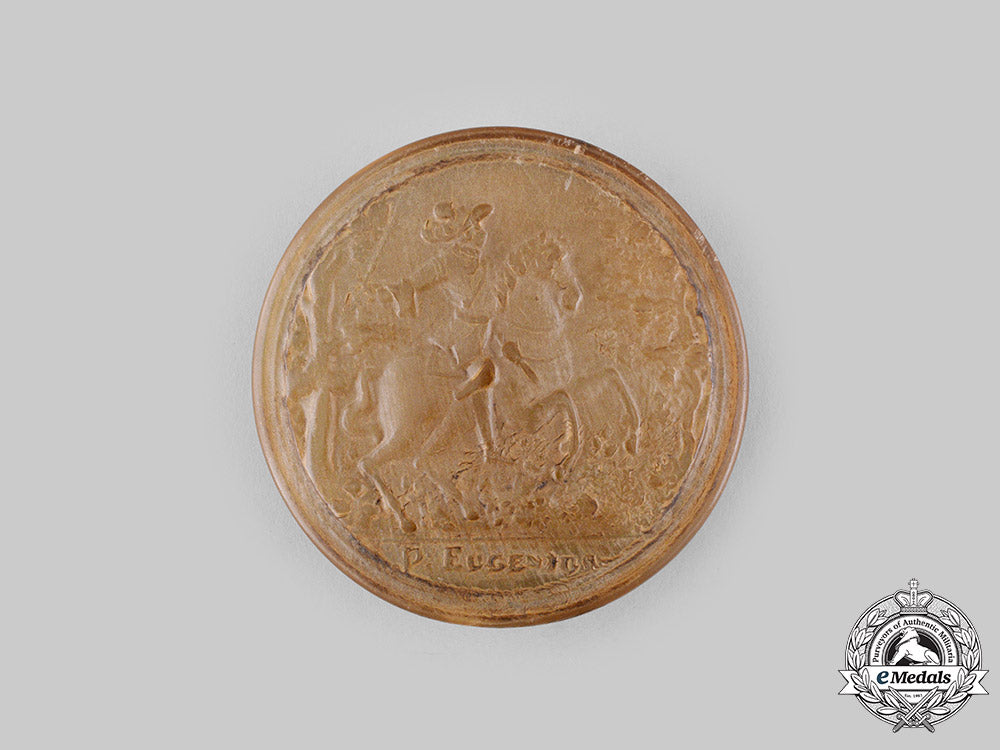
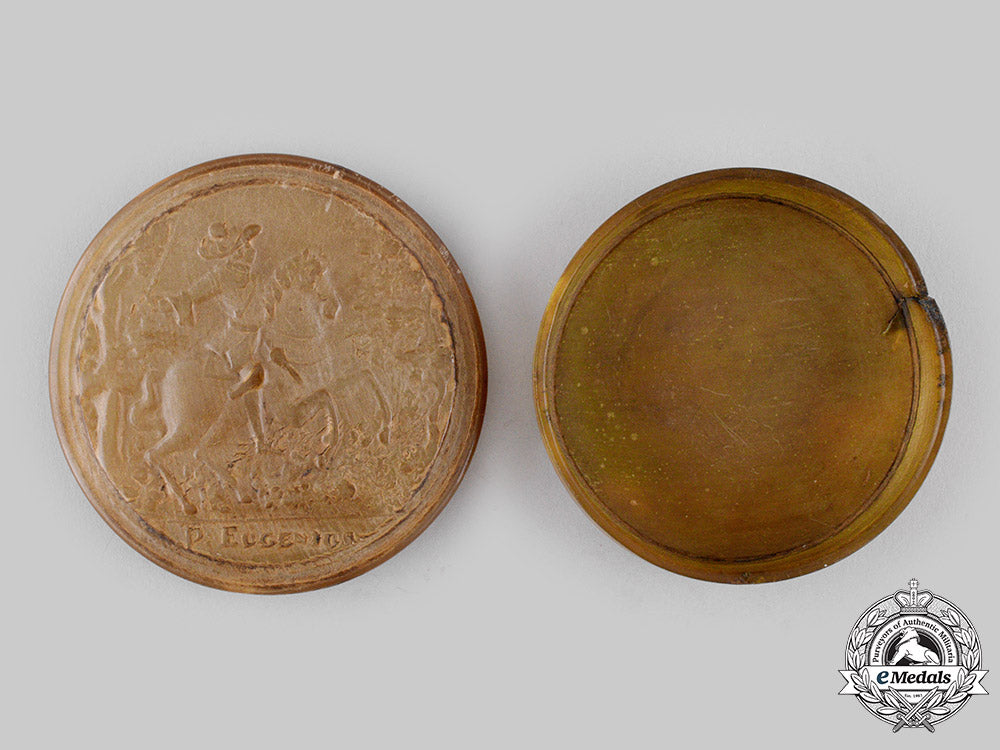

Austria, Habsburg Monarchy. A Prince Eugene Francis Of Savoy Snuff Box
Austria, Habsburg Monarchy. A Prince Eugene Francis Of Savoy Snuff Box
SKU: ITEM: EU17348
0% Buyer's Premium
Current Bid:
Your Max Bid:
Bid History:
Time Remaining:
Couldn't load pickup availability
Shipping Details
Shipping Details
eMedals offers rapid domestic and international shipping. Orders received prior to 12:00pm (EST) will be shipped on the same business day.* Orders placed on Canadian Federal holidays will be dispatched the subsequent business day. Courier tracking numbers are provided for all shipments. All items purchased from eMedals can be returned for a full monetary refund or merchandise credit, providing the criteria presented in our Terms & Conditions are met. *Please note that the addition of a COA may impact dispatch time.
Shipping Details
eMedals offers rapid domestic and international shipping. Orders received prior to 12:00pm (EST) will be shipped on the same business day.* Orders placed on Canadian Federal holidays will be dispatched the subsequent business day. Courier tracking numbers are provided for all shipments. All items purchased from eMedals can be returned for a full monetary refund or merchandise credit, providing the criteria presented in our Terms & Conditions are met. *Please note that the addition of a COA may impact dispatch time.
Description
Description
(Prince Eugène François de Savoie-Carignano). Includes two pieces fabricated from tortoise shell, the lid illustrating Prince Eugene Francis of Savoy-Carignano on horseback, facing to the right with trees on either side, inscribed in Latin "P: EUGENIUS" (Prince Eugene) below, all within a circular frame, the lid measuring 77.3 mm in diameter x 11.5 mm in height, the accompanying base measuring 72 mm in diameter x 15.5 mm in height and exhibiting one crack extending from top to bottom on the side. Very fine.
Footnote: Prince Eugene Francis of Savoy-Carignano (born October 1663 in Hôtel de Soissons, Paris, France; died April 21, 1736 in Vienna, Austria) was a member of the House of Savoy and Generalfeldmarschall of the Imperial Army and statesman of the Holy Roman Empire and the Archduchy of Austria and one of the most successful military commanders in modern European history, rising to the highest offices of state at the Imperial court in Vienna. Born in Paris, Eugene grew up around the court of King Louis XIV of France. Based on his poor physique and bearing, the Prince was initially prepared for a clerical career, but by the age of 19 he had determined on a military career. Following a scandal involving his mother Olympe, he was rejected by Louis XIV for service in the French army. Eugene moved to Austria and transferred his loyalty to the Habsburg Monarchy.
Spanning six decades, Eugene served three Holy Roman Emperors: Leopold I, Joseph I, and Charles VI. He first saw action against the Ottoman Turks at the Siege of Vienna in 1683 and the subsequent War of the Holy League, before serving in the Nine Years' War, fighting alongside his cousin, the Duke of Savoy. However, the Prince's fame was secured with his decisive victory against the Ottomans at the Battle of Zenta in 1697, earning him Europe-wide fame. Eugene enhanced his standing during the War of the Spanish Succession, where his partnership with the Duke of Marlborough secured victories against the French on the fields of Blenheim (1704), Oudenarde (1708), and Malplaquet (1709); he gained further success in the war as Imperial commander in northern Italy, most notably at the Battle of Turin (1706). Renewed hostilities against the Ottomans in the Austro-Turkish War consolidated his reputation, with victories at the battles of Petrovaradin (1716), and the decisive encounter at Belgrade (1717).
Throughout the late 1720's, Eugene's influence and skillful diplomacy managed to secure the Emperor powerful allies in his dynastic struggles with the Bourbon powers, but physically and mentally fragile in his later years, Eugene enjoyed less success as commander-in-chief of the army during his final conflict, the War of the Polish Succession. Nevertheless, in Austria, Eugene's reputation remains unrivalled. Although opinions differ as to his character, there is no dispute over his great achievements: he helped to save the Habsburg Empire from Frenchconquest; he broke the westward thrust of the Ottomans, liberating central Europe after a century and a half of Turkish occupation; and he was one of the great patrons of the arts whose building legacy can still be seen in Vienna today. Eugene died in his sleep at his home on April 21, 1736, at the age of 72 and is buried in St. Stephen's Cathedral in Vienna.
Description
(Prince Eugène François de Savoie-Carignano). Includes two pieces fabricated from tortoise shell, the lid illustrating Prince Eugene Francis of Savoy-Carignano on horseback, facing to the right with trees on either side, inscribed in Latin "P: EUGENIUS" (Prince Eugene) below, all within a circular frame, the lid measuring 77.3 mm in diameter x 11.5 mm in height, the accompanying base measuring 72 mm in diameter x 15.5 mm in height and exhibiting one crack extending from top to bottom on the side. Very fine.
Footnote: Prince Eugene Francis of Savoy-Carignano (born October 1663 in Hôtel de Soissons, Paris, France; died April 21, 1736 in Vienna, Austria) was a member of the House of Savoy and Generalfeldmarschall of the Imperial Army and statesman of the Holy Roman Empire and the Archduchy of Austria and one of the most successful military commanders in modern European history, rising to the highest offices of state at the Imperial court in Vienna. Born in Paris, Eugene grew up around the court of King Louis XIV of France. Based on his poor physique and bearing, the Prince was initially prepared for a clerical career, but by the age of 19 he had determined on a military career. Following a scandal involving his mother Olympe, he was rejected by Louis XIV for service in the French army. Eugene moved to Austria and transferred his loyalty to the Habsburg Monarchy.
Spanning six decades, Eugene served three Holy Roman Emperors: Leopold I, Joseph I, and Charles VI. He first saw action against the Ottoman Turks at the Siege of Vienna in 1683 and the subsequent War of the Holy League, before serving in the Nine Years' War, fighting alongside his cousin, the Duke of Savoy. However, the Prince's fame was secured with his decisive victory against the Ottomans at the Battle of Zenta in 1697, earning him Europe-wide fame. Eugene enhanced his standing during the War of the Spanish Succession, where his partnership with the Duke of Marlborough secured victories against the French on the fields of Blenheim (1704), Oudenarde (1708), and Malplaquet (1709); he gained further success in the war as Imperial commander in northern Italy, most notably at the Battle of Turin (1706). Renewed hostilities against the Ottomans in the Austro-Turkish War consolidated his reputation, with victories at the battles of Petrovaradin (1716), and the decisive encounter at Belgrade (1717).
Throughout the late 1720's, Eugene's influence and skillful diplomacy managed to secure the Emperor powerful allies in his dynastic struggles with the Bourbon powers, but physically and mentally fragile in his later years, Eugene enjoyed less success as commander-in-chief of the army during his final conflict, the War of the Polish Succession. Nevertheless, in Austria, Eugene's reputation remains unrivalled. Although opinions differ as to his character, there is no dispute over his great achievements: he helped to save the Habsburg Empire from Frenchconquest; he broke the westward thrust of the Ottomans, liberating central Europe after a century and a half of Turkish occupation; and he was one of the great patrons of the arts whose building legacy can still be seen in Vienna today. Eugene died in his sleep at his home on April 21, 1736, at the age of 72 and is buried in St. Stephen's Cathedral in Vienna.
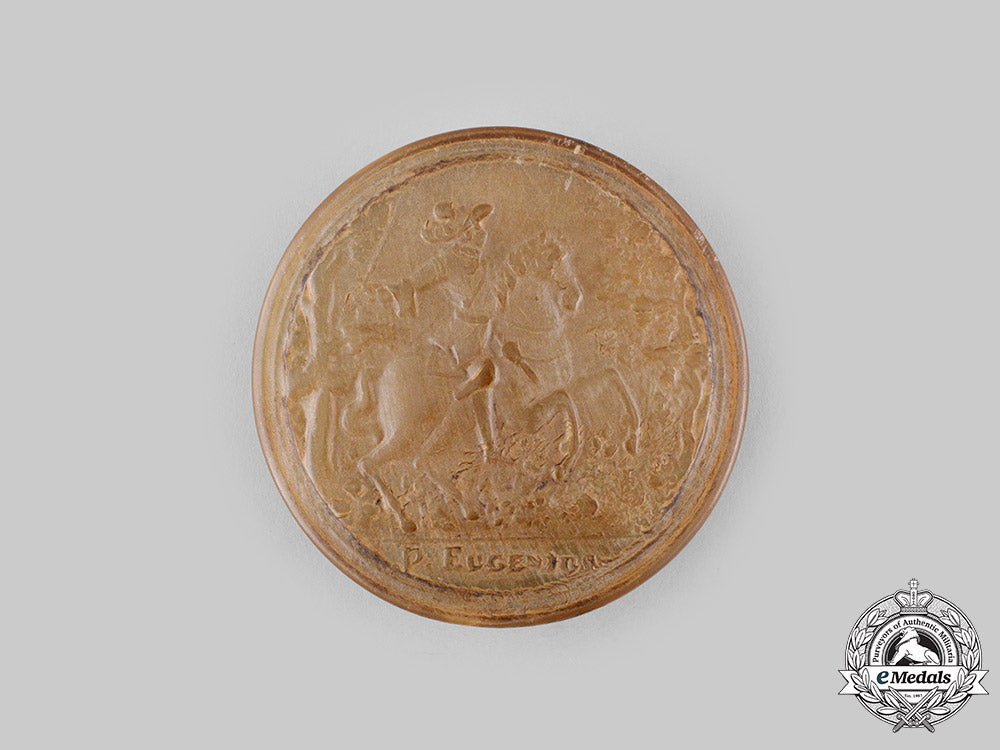
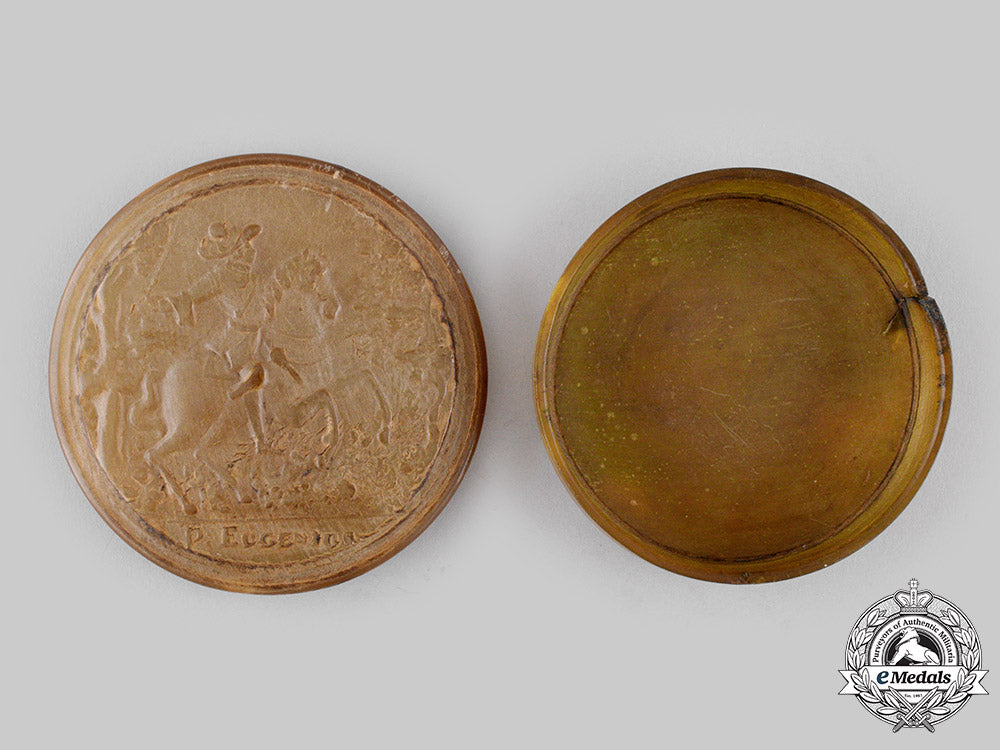
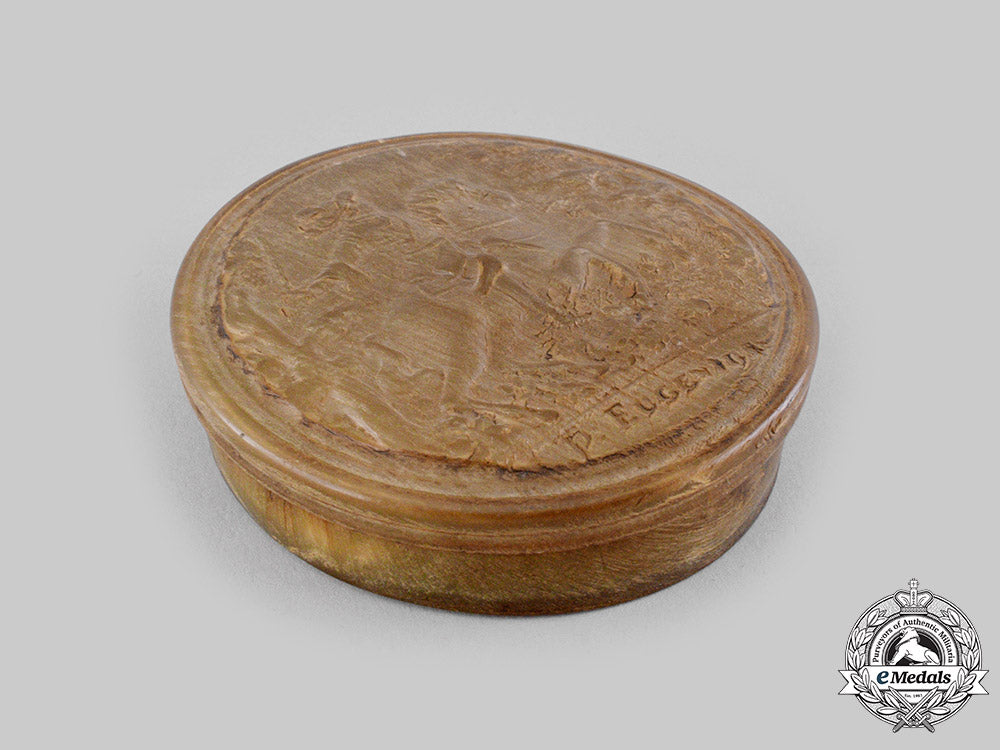
You May Also Like
Canada, Commonwealth. A Military Cross with Bar Group to Captain Newell, RCHA, 1944
C7202
Canada, CEF. A First War DSO and MC with Bar to Major McCaghey, Gallantry at Lens and Camery, 1918
C7199
Spain, Spanish State. A Medal of the Russian Campaign, with Case, by Diez y Campañia
EU24085
Germany, Third Reich. A Mixed Lot of Uniform Insignia for Military and Civil Service
G60811
Germany, Third Reich. A Mixed Lot of Shoulder Boards for Railway and Police Personnel
G60810
-
Canada, Commonwealth. A Military Cross with Bar Group to Captain Newell, RCHA, 1944
C7202
Add to CartRegular price $3,780 USDRegular price $0 USD Sale price $3,780 USDUnit price / per -
Canada, CEF. A First War DSO and MC with Bar to Major McCaghey, Gallantry at Lens and Camery, 1918
C7199
Add to CartRegular price $4,155 USDRegular price $0 USD Sale price $4,155 USDUnit price / per -
Spain, Spanish State. A Medal of the Russian Campaign, with Case, by Diez y Campañia
EU24085
Add to CartRegular price $340 USDRegular price $0 USD Sale price $340 USDUnit price / per -
Germany, Third Reich. A Mixed Lot of Uniform Insignia for Military and Civil Service
G60811
Add to CartRegular price $135 USDRegular price $0 USD Sale price $135 USDUnit price / per -
Germany, Third Reich. A Mixed Lot of Shoulder Boards for Railway and Police Personnel
G60810
Add to CartRegular price $135 USDRegular price $0 USD Sale price $135 USDUnit price / per
Do you have a similar item you are interested in selling?
Please complete the form and our client care representatives will contact you.
Sell Item










